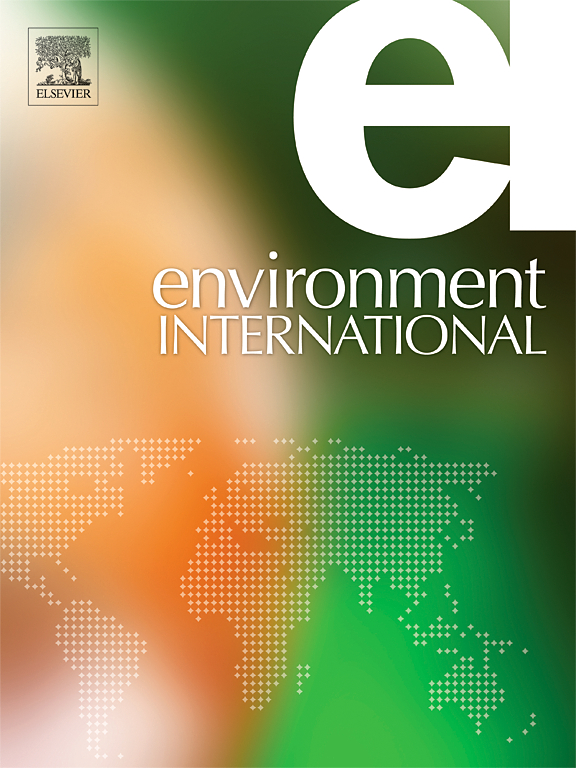Disentangling the Fe species-dependent electron donating capacity and abiotic reduction capacity towards nitrobenzene of the sediment cores
IF 10.3
1区 环境科学与生态学
Q1 ENVIRONMENTAL SCIENCES
引用次数: 0
Abstract
Iron is a redox-sensitive element and plays a critical role in governing the abiotic natural reduction of organic contaminants in aquifers. However, proper quantification and prediction of contaminant attenuation processes mediated by Fe species remain inadequately characterized, particularly under field conditions. Herein, 43 aquifer sediment cores were collected from four locations at two sites, and nitrobenzene (NB) was used as a representative organic contaminant to evaluate the Fe species–dependent reduction capacity. A systematic investigation was conducted to establish the relationships among Fe species distribution, electron donating capacity (EDC), and abiotic reduction capacity toward NB of sediments. Results revealed a strong positive correlation between carbonate-bound iron (Fecarb) concentration (0.06–3.11 mg·g-1) and sediment EDC (R2 = 0.89, p < 0.05, n = 10) when silicate-bonded iron (FeSi) content was low (<4.0 mg·g-1). For the reduction of NB, due to thermodynamic constraints imposed on certain electron donors, the correlation between EDC and NB reduction rate was weak. However, Fecarb content exhibited a strong quantitative linear correlation with the reduction rate of NB (R2 = 0.89; p < 0.05; n = 19). The derived quantitative relationship indicates a dose-dependent increase in the NB reduction rate of 0.12 d−1 for every 1 mg·g-1 increase in Fecarb content. The 95 % prediction interval can be used to effectively predict the NB reduction kinetics of sediments. These findings provide a new perspective for predicting the abiotic natural reduction capacity of sediments and groundwater organic contaminant remediation.


沉积物岩心对硝基苯的非生物还原能力和铁依赖的给电子能力
铁是一种氧化还原敏感元素,在控制含水层中有机污染物的非生物自然还原中起着关键作用。然而,适当的定量和预测由铁介导的污染物衰减过程仍然没有充分表征,特别是在野外条件下。本研究从2个站点的4个地点采集了43个含水层沉积物岩心,并以硝基苯(Nitrobenzene, NB)作为代表性有机污染物,评价了其铁依赖的还原能力。系统研究了沉积物中Fe种类分布、给电子能力(EDC)和对NB的非生物还原能力之间的关系。结果表明,当硅酸结合铁(FeSi)含量较低时(<; 4.0毫克/克)。对于NB的还原,由于某些电子给体的热力学约束,EDC与NB还原速率的相关性较弱。而Fecarb含量与NB的还原率呈较强的定量线性相关(R2 = 0.89;p & lt; 0.05;n = 19)。推导出的定量关系表明,Fecarb含量每增加1 mg/g, NB还原率呈剂量依赖性增加0.12 d−1。95 %的预测区间可以有效预测沉积物的NB还原动力学。这些发现为预测沉积物的非生物自然还原能力和地下水有机污染物的修复提供了新的视角。
本文章由计算机程序翻译,如有差异,请以英文原文为准。
求助全文
约1分钟内获得全文
求助全文
来源期刊

Environment International
环境科学-环境科学
CiteScore
21.90
自引率
3.40%
发文量
734
审稿时长
2.8 months
期刊介绍:
Environmental Health publishes manuscripts focusing on critical aspects of environmental and occupational medicine, including studies in toxicology and epidemiology, to illuminate the human health implications of exposure to environmental hazards. The journal adopts an open-access model and practices open peer review.
It caters to scientists and practitioners across all environmental science domains, directly or indirectly impacting human health and well-being. With a commitment to enhancing the prevention of environmentally-related health risks, Environmental Health serves as a public health journal for the community and scientists engaged in matters of public health significance concerning the environment.
 求助内容:
求助内容: 应助结果提醒方式:
应助结果提醒方式:


